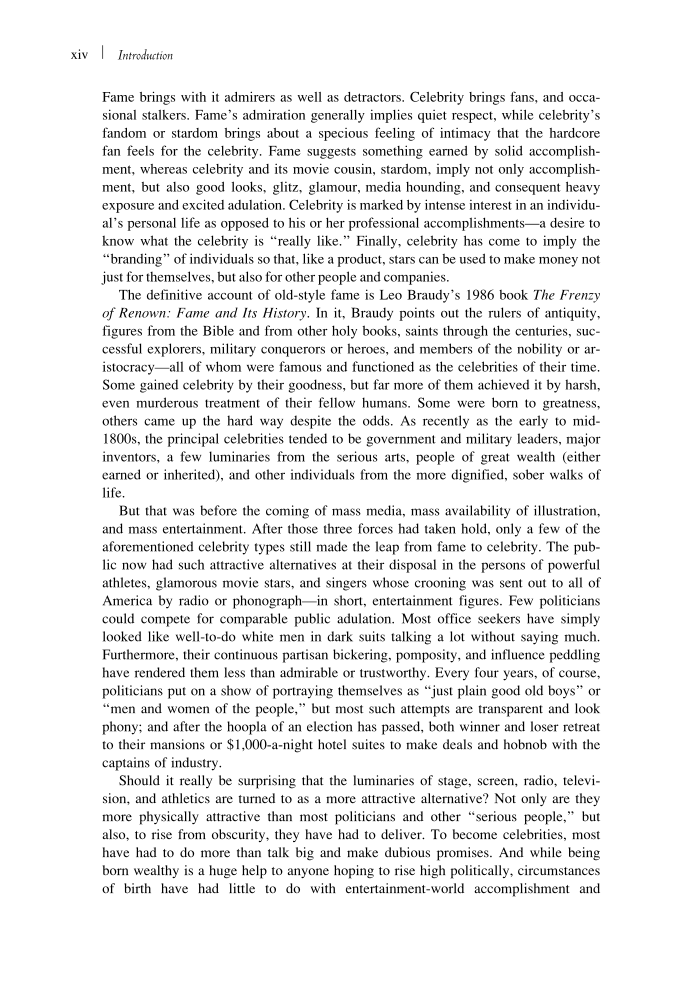Fame brings with it admirers as well as detractors. Celebrity brings fans, and occa- sional stalkers. Fame’s admiration generally implies quiet respect, while celebrity’s fandom or stardom brings about a specious feeling of intimacy that the hardcore fan feels for the celebrity. Fame suggests something earned by solid accomplish- ment, whereas celebrity and its movie cousin, stardom, imply not only accomplish- ment, but also good looks, glitz, glamour, media hounding, and consequent heavy exposure and excited adulation. Celebrity is marked by intense interest in an individu- al’s personal life as opposed to his or her professional accomplishments—a desire to know what the celebrity is ‘‘really like.’’ Finally, celebrity has come to imply the ‘‘branding’’ of individuals so that, like a product, stars can be used to make money not just for themselves, but also for other people and companies. The definitive account of old-style fame is Leo Braudy’s 1986 book The Frenzy of Renown: Fame and Its History. In it, Braudy points out the rulers of antiquity, figures from the Bible and from other holy books, saints through the centuries, suc- cessful explorers, military conquerors or heroes, and members of the nobility or ar- istocracy—all of whom were famous and functioned as the celebrities of their time. Some gained celebrity by their goodness, but far more of them achieved it by harsh, even murderous treatment of their fellow humans. Some were born to greatness, others came up the hard way despite the odds. As recently as the early to mid- 1800s, the principal celebrities tended to be government and military leaders, major inventors, a few luminaries from the serious arts, people of great wealth (either earned or inherited), and other individuals from the more dignified, sober walks of life. But that was before the coming of mass media, mass availability of illustration, and mass entertainment. After those three forces had taken hold, only a few of the aforementioned celebrity types still made the leap from fame to celebrity. The pub- lic now had such attractive alternatives at their disposal in the persons of powerful athletes, glamorous movie stars, and singers whose crooning was sent out to all of America by radio or phonograph—in short, entertainment figures. Few politicians could compete for comparable public adulation. Most office seekers have simply looked like well-to-do white men in dark suits talking a lot without saying much. Furthermore, their continuous partisan bickering, pomposity, and influence peddling have rendered them less than admirable or trustworthy. Every four years, of course, politicians put on a show of portraying themselves as ‘‘just plain good old boys’’ or ‘‘men and women of the people,’’ but most such attempts are transparent and look phony and after the hoopla of an election has passed, both winner and loser retreat to their mansions or $1,000-a-night hotel suites to make deals and hobnob with the captains of industry. Should it really be surprising that the luminaries of stage, screen, radio, televi- sion, and athletics are turned to as a more attractive alternative? Not only are they more physically attractive than most politicians and other ‘‘serious people,’’ but also, to rise from obscurity, they have had to deliver. To become celebrities, most have had to do more than talk big and make dubious promises. And while being born wealthy is a huge help to anyone hoping to rise high politically, circumstances of birth have had little to do with entertainment-world accomplishment and xiv | Introduction
Document Details My Account Print multiple pages
Print
You have printed 0 times in the last 24 hours.
Your print count will reset on at .
You may print 0 more time(s) before then.
You may print a maximum of 0 pages at a time.

































































































































































































































































































































































































